Management Accounting Report
VerifiedAdded on 2020/12/29
|21
|5511
|494
Report
AI Summary
This report provides a comprehensive analysis of management accounting, covering its importance in decision-making, cost control, and financial planning. It examines various costing techniques, planning tools, and problem-solving methods, offering insights into their application and effectiveness in business operations.
Contribute Materials
Your contribution can guide someone’s learning journey. Share your
documents today.
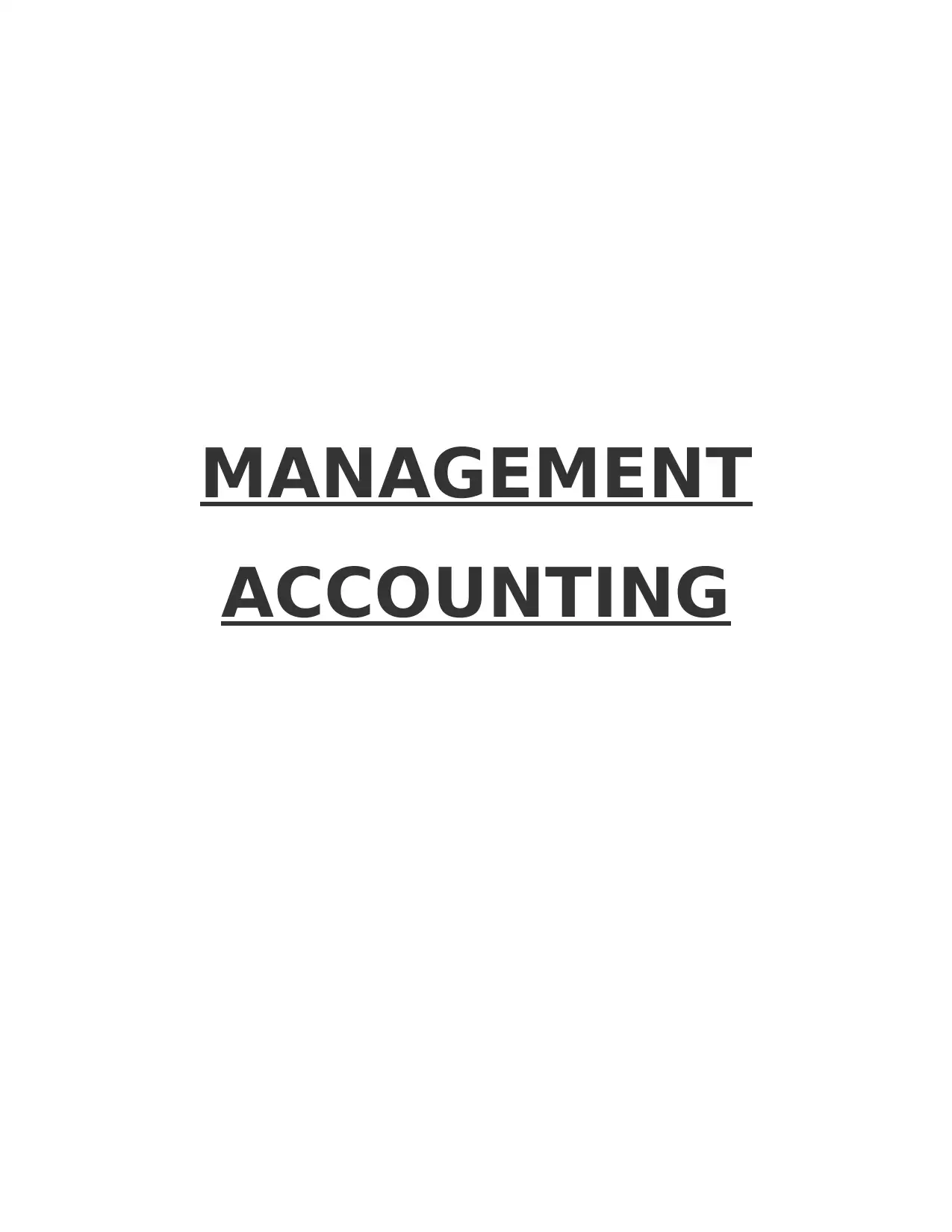
MANAGEMENT
ACCOUNTING
ACCOUNTING
Secure Best Marks with AI Grader
Need help grading? Try our AI Grader for instant feedback on your assignments.
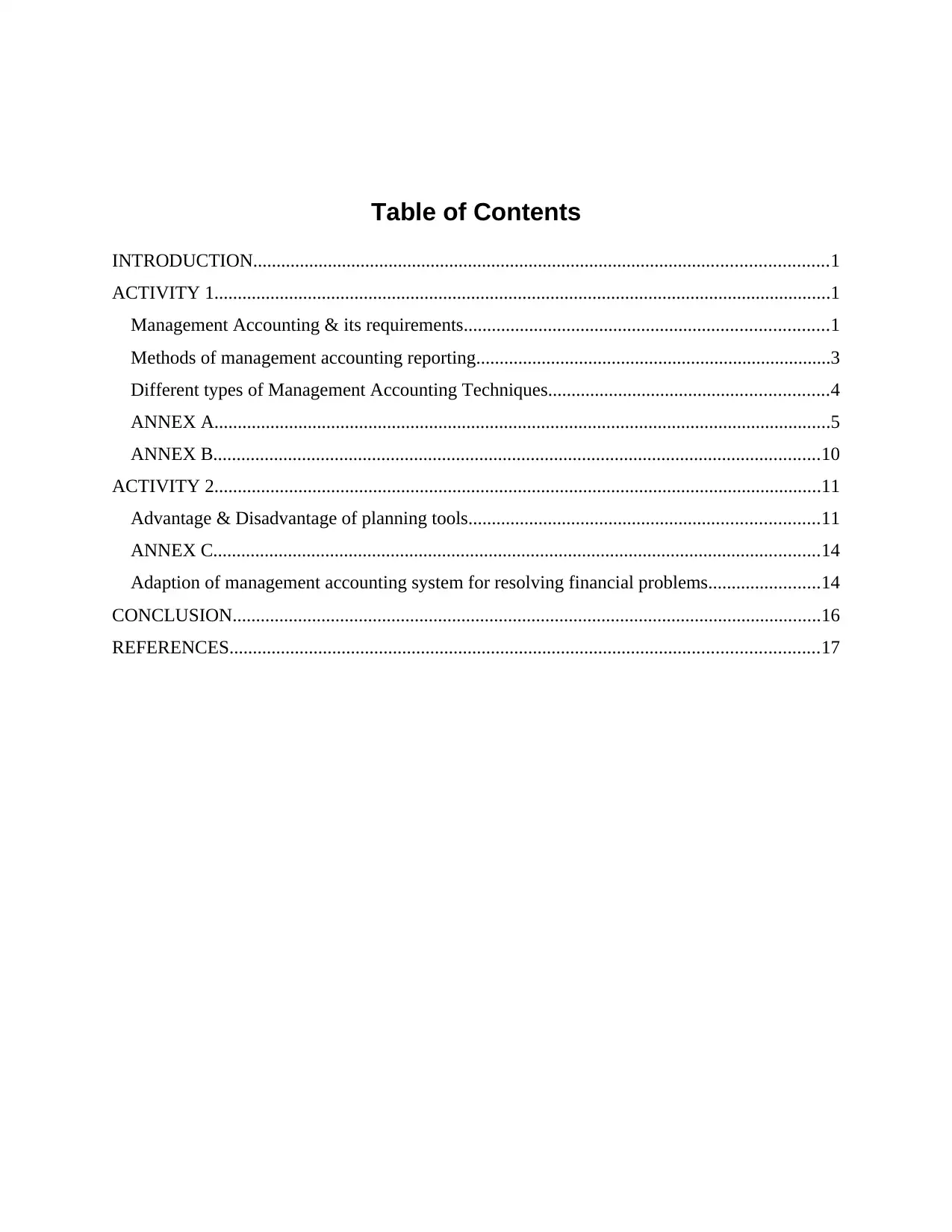
Table of Contents
INTRODUCTION...........................................................................................................................1
ACTIVITY 1....................................................................................................................................1
Management Accounting & its requirements..............................................................................1
Methods of management accounting reporting............................................................................3
Different types of Management Accounting Techniques............................................................4
ANNEX A....................................................................................................................................5
ANNEX B..................................................................................................................................10
ACTIVITY 2..................................................................................................................................11
Advantage & Disadvantage of planning tools...........................................................................11
ANNEX C..................................................................................................................................14
Adaption of management accounting system for resolving financial problems........................14
CONCLUSION..............................................................................................................................16
REFERENCES..............................................................................................................................17
INTRODUCTION...........................................................................................................................1
ACTIVITY 1....................................................................................................................................1
Management Accounting & its requirements..............................................................................1
Methods of management accounting reporting............................................................................3
Different types of Management Accounting Techniques............................................................4
ANNEX A....................................................................................................................................5
ANNEX B..................................................................................................................................10
ACTIVITY 2..................................................................................................................................11
Advantage & Disadvantage of planning tools...........................................................................11
ANNEX C..................................................................................................................................14
Adaption of management accounting system for resolving financial problems........................14
CONCLUSION..............................................................................................................................16
REFERENCES..............................................................................................................................17
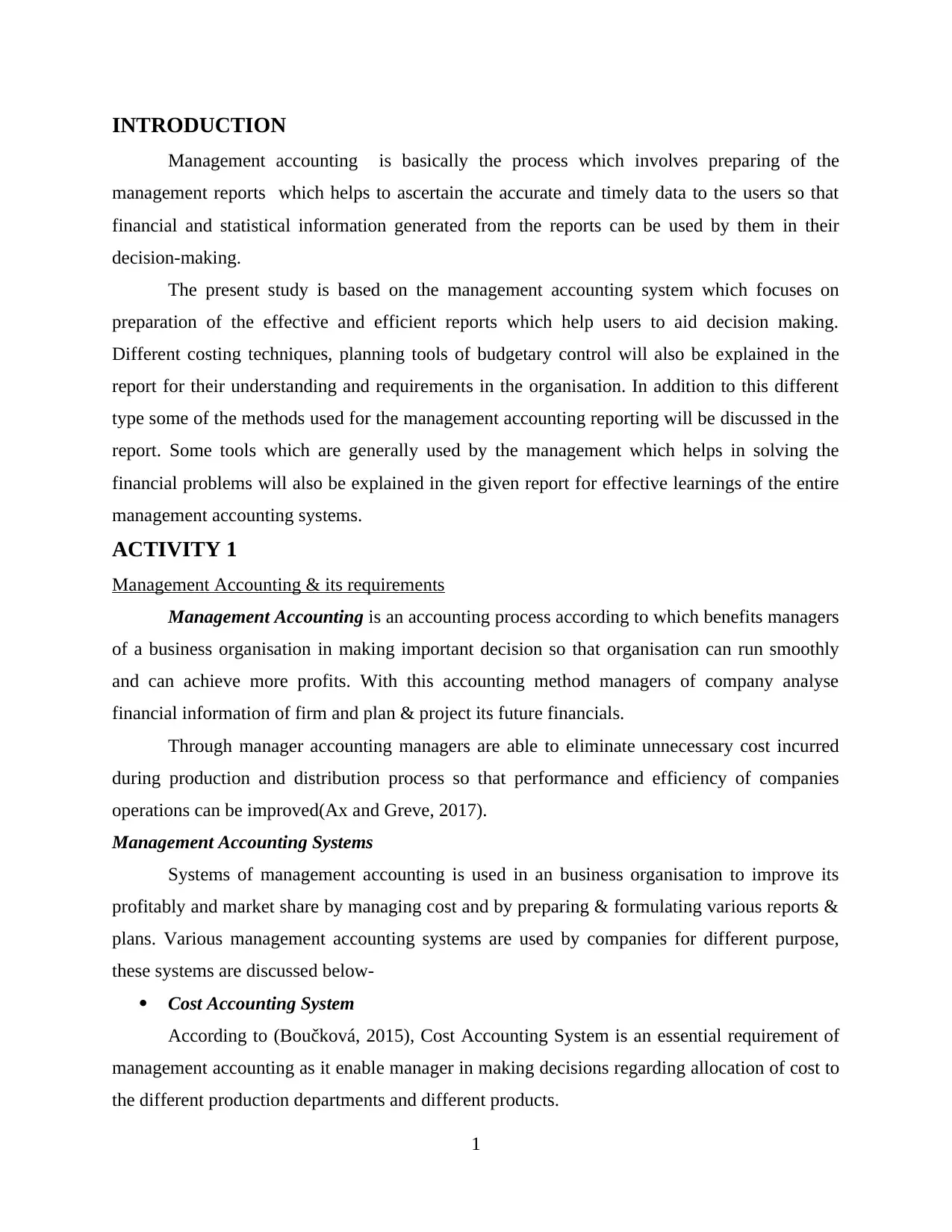
INTRODUCTION
Management accounting is basically the process which involves preparing of the
management reports which helps to ascertain the accurate and timely data to the users so that
financial and statistical information generated from the reports can be used by them in their
decision-making.
The present study is based on the management accounting system which focuses on
preparation of the effective and efficient reports which help users to aid decision making.
Different costing techniques, planning tools of budgetary control will also be explained in the
report for their understanding and requirements in the organisation. In addition to this different
type some of the methods used for the management accounting reporting will be discussed in the
report. Some tools which are generally used by the management which helps in solving the
financial problems will also be explained in the given report for effective learnings of the entire
management accounting systems.
ACTIVITY 1
Management Accounting & its requirements
Management Accounting is an accounting process according to which benefits managers
of a business organisation in making important decision so that organisation can run smoothly
and can achieve more profits. With this accounting method managers of company analyse
financial information of firm and plan & project its future financials.
Through manager accounting managers are able to eliminate unnecessary cost incurred
during production and distribution process so that performance and efficiency of companies
operations can be improved(Ax and Greve, 2017).
Management Accounting Systems
Systems of management accounting is used in an business organisation to improve its
profitably and market share by managing cost and by preparing & formulating various reports &
plans. Various management accounting systems are used by companies for different purpose,
these systems are discussed below-
Cost Accounting System
According to (Boučková, 2015), Cost Accounting System is an essential requirement of
management accounting as it enable manager in making decisions regarding allocation of cost to
the different production departments and different products.
1
Management accounting is basically the process which involves preparing of the
management reports which helps to ascertain the accurate and timely data to the users so that
financial and statistical information generated from the reports can be used by them in their
decision-making.
The present study is based on the management accounting system which focuses on
preparation of the effective and efficient reports which help users to aid decision making.
Different costing techniques, planning tools of budgetary control will also be explained in the
report for their understanding and requirements in the organisation. In addition to this different
type some of the methods used for the management accounting reporting will be discussed in the
report. Some tools which are generally used by the management which helps in solving the
financial problems will also be explained in the given report for effective learnings of the entire
management accounting systems.
ACTIVITY 1
Management Accounting & its requirements
Management Accounting is an accounting process according to which benefits managers
of a business organisation in making important decision so that organisation can run smoothly
and can achieve more profits. With this accounting method managers of company analyse
financial information of firm and plan & project its future financials.
Through manager accounting managers are able to eliminate unnecessary cost incurred
during production and distribution process so that performance and efficiency of companies
operations can be improved(Ax and Greve, 2017).
Management Accounting Systems
Systems of management accounting is used in an business organisation to improve its
profitably and market share by managing cost and by preparing & formulating various reports &
plans. Various management accounting systems are used by companies for different purpose,
these systems are discussed below-
Cost Accounting System
According to (Boučková, 2015), Cost Accounting System is an essential requirement of
management accounting as it enable manager in making decisions regarding allocation of cost to
the different production departments and different products.
1

This is the most important management accounting systems which is required to use in
managing different types of cost of manufacturing such as labour cost, cost of material and
overhead cost. With this accounting system a company is able to sale its product and services at a
lower price by minimising cost and setting up higher profit margin which in turn enhances
profitability and performance. This systems also required for companies in tracking its inventory
level and requirement of raw materials because cost of a product is determined after evaluating
these elements(Bromwich and Scapens, 2016).
Further, this provide various Cost Accounting Techniques with which a business
organisation is able to analyse cost of its product and service and make budget of future expenses
of production. These accounting techniques are Job Costing, Process Costing, Contract Costing,
Marginal Costing and Services Costing. This is beneficial for a business venture which is
including wide range of products and services in its product portfolio. Because, this type of
companies can use suitable techniques of each department to determine and manage cost.
This system is also required in management accounting as it compare actual cost of
product with the standard cost, differentiate direct & indirect cost and operating and non
operating expenses. Inventory Management System
This system is also an essential requirement of management accounting according to (),
as it helps manager of production department by determining requirement and availability of
inventory. Further, manager are able to manage inventory according to demand of customers and
requirement of production department. It is necessary for a company to manage its stock as
without inventory a company can not manufacture its goods and services.
Further, this system uses various software's so that inventory managers can track level of
inventory, sales volume and cost of inventory available. Further, this system is require to
generate bill of all the material included in production process and supports in placing orders.
Most important benefit of this system is it helps managers in managing supply chain of a
company as without checking inventory level a company is unable to place further order for raw
materials(Carlsson-Wall, Kraus and Lind, 2015). Job Costing Systems
This system is required as with this manager can determine cost involved in a particular
job and it gives all the related information of manufacturing cost of each job separately which in
2
managing different types of cost of manufacturing such as labour cost, cost of material and
overhead cost. With this accounting system a company is able to sale its product and services at a
lower price by minimising cost and setting up higher profit margin which in turn enhances
profitability and performance. This systems also required for companies in tracking its inventory
level and requirement of raw materials because cost of a product is determined after evaluating
these elements(Bromwich and Scapens, 2016).
Further, this provide various Cost Accounting Techniques with which a business
organisation is able to analyse cost of its product and service and make budget of future expenses
of production. These accounting techniques are Job Costing, Process Costing, Contract Costing,
Marginal Costing and Services Costing. This is beneficial for a business venture which is
including wide range of products and services in its product portfolio. Because, this type of
companies can use suitable techniques of each department to determine and manage cost.
This system is also required in management accounting as it compare actual cost of
product with the standard cost, differentiate direct & indirect cost and operating and non
operating expenses. Inventory Management System
This system is also an essential requirement of management accounting according to (),
as it helps manager of production department by determining requirement and availability of
inventory. Further, manager are able to manage inventory according to demand of customers and
requirement of production department. It is necessary for a company to manage its stock as
without inventory a company can not manufacture its goods and services.
Further, this system uses various software's so that inventory managers can track level of
inventory, sales volume and cost of inventory available. Further, this system is require to
generate bill of all the material included in production process and supports in placing orders.
Most important benefit of this system is it helps managers in managing supply chain of a
company as without checking inventory level a company is unable to place further order for raw
materials(Carlsson-Wall, Kraus and Lind, 2015). Job Costing Systems
This system is required as with this manager can determine cost involved in a particular
job and it gives all the related information of manufacturing cost of each job separately which in
2
Secure Best Marks with AI Grader
Need help grading? Try our AI Grader for instant feedback on your assignments.
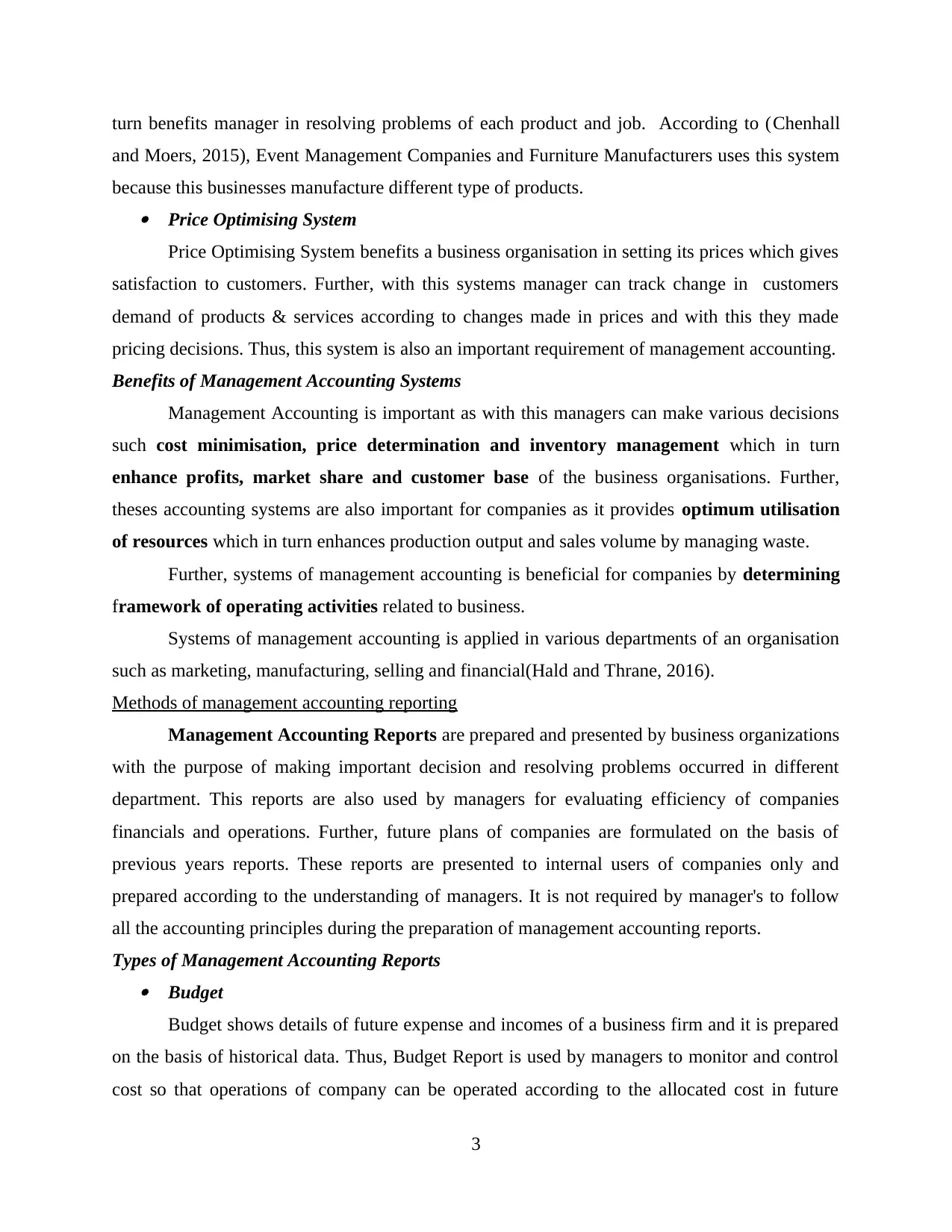
turn benefits manager in resolving problems of each product and job. According to (Chenhall
and Moers, 2015), Event Management Companies and Furniture Manufacturers uses this system
because this businesses manufacture different type of products. Price Optimising System
Price Optimising System benefits a business organisation in setting its prices which gives
satisfaction to customers. Further, with this systems manager can track change in customers
demand of products & services according to changes made in prices and with this they made
pricing decisions. Thus, this system is also an important requirement of management accounting.
Benefits of Management Accounting Systems
Management Accounting is important as with this managers can make various decisions
such cost minimisation, price determination and inventory management which in turn
enhance profits, market share and customer base of the business organisations. Further,
theses accounting systems are also important for companies as it provides optimum utilisation
of resources which in turn enhances production output and sales volume by managing waste.
Further, systems of management accounting is beneficial for companies by determining
framework of operating activities related to business.
Systems of management accounting is applied in various departments of an organisation
such as marketing, manufacturing, selling and financial(Hald and Thrane, 2016).
Methods of management accounting reporting
Management Accounting Reports are prepared and presented by business organizations
with the purpose of making important decision and resolving problems occurred in different
department. This reports are also used by managers for evaluating efficiency of companies
financials and operations. Further, future plans of companies are formulated on the basis of
previous years reports. These reports are presented to internal users of companies only and
prepared according to the understanding of managers. It is not required by manager's to follow
all the accounting principles during the preparation of management accounting reports.
Types of Management Accounting Reports Budget
Budget shows details of future expense and incomes of a business firm and it is prepared
on the basis of historical data. Thus, Budget Report is used by managers to monitor and control
cost so that operations of company can be operated according to the allocated cost in future
3
and Moers, 2015), Event Management Companies and Furniture Manufacturers uses this system
because this businesses manufacture different type of products. Price Optimising System
Price Optimising System benefits a business organisation in setting its prices which gives
satisfaction to customers. Further, with this systems manager can track change in customers
demand of products & services according to changes made in prices and with this they made
pricing decisions. Thus, this system is also an important requirement of management accounting.
Benefits of Management Accounting Systems
Management Accounting is important as with this managers can make various decisions
such cost minimisation, price determination and inventory management which in turn
enhance profits, market share and customer base of the business organisations. Further,
theses accounting systems are also important for companies as it provides optimum utilisation
of resources which in turn enhances production output and sales volume by managing waste.
Further, systems of management accounting is beneficial for companies by determining
framework of operating activities related to business.
Systems of management accounting is applied in various departments of an organisation
such as marketing, manufacturing, selling and financial(Hald and Thrane, 2016).
Methods of management accounting reporting
Management Accounting Reports are prepared and presented by business organizations
with the purpose of making important decision and resolving problems occurred in different
department. This reports are also used by managers for evaluating efficiency of companies
financials and operations. Further, future plans of companies are formulated on the basis of
previous years reports. These reports are presented to internal users of companies only and
prepared according to the understanding of managers. It is not required by manager's to follow
all the accounting principles during the preparation of management accounting reports.
Types of Management Accounting Reports Budget
Budget shows details of future expense and incomes of a business firm and it is prepared
on the basis of historical data. Thus, Budget Report is used by managers to monitor and control
cost so that operations of company can be operated according to the allocated cost in future
3

Financial plan. Further, companies develop budget for different departments which helps
managers in evaluating performance of each department.
This report is essential for management accounting as with this managers are able to set
incentives for their employees and can negotiate with suppliers for prices of raw
material(Honggowati and et.al., 2017). Cost Accounting Reports
These reports are prepared for computation, controlling and monitoring cost involved in
manufacturing of products. All types of cost such as raw material, indirect & direct labour and
Overheads are included in this reports with this managers are able to make decisions related to
cost reduction, management of waste, determining cost of overheads and labour. This report
gives an exact information of expenses incurred by company. Performance Reports
Performance Reports are prepared with the purpose of analysing financial, managerial
and operational performance of a business organisations. Managers of a business firm set future
objectives and goals in accordance with these reports. Further, this reports also helps managers in
developing future strategies so that organisation can achieve higher profits and market share.
Different types of Management Accounting Techniques
Management Accounting Techniques
Management Accounting techniques are used by business organisation with the purpose
of managing risk, developing strategies and taking decision related to business expansion. This
techniques are used by businesses for analysing both financial and non financial information.
Various management accounting use by companies are discussed below-
Marginal Costing
Marginal Cost consider additional cost incurred in production of goods and services due
to increase in sales units. Thus, these technique of management accounting helps business firms
in calculating and determining extra cost included in production process (Marginal Cost). This
techniques gives accurate amount of profit to the business firms as manufacturing cost of product
is controlled and monitored on a daily basis and manager make decisions to improve the cost
with the changes(Jansen, 2018).
Advantage
4
managers in evaluating performance of each department.
This report is essential for management accounting as with this managers are able to set
incentives for their employees and can negotiate with suppliers for prices of raw
material(Honggowati and et.al., 2017). Cost Accounting Reports
These reports are prepared for computation, controlling and monitoring cost involved in
manufacturing of products. All types of cost such as raw material, indirect & direct labour and
Overheads are included in this reports with this managers are able to make decisions related to
cost reduction, management of waste, determining cost of overheads and labour. This report
gives an exact information of expenses incurred by company. Performance Reports
Performance Reports are prepared with the purpose of analysing financial, managerial
and operational performance of a business organisations. Managers of a business firm set future
objectives and goals in accordance with these reports. Further, this reports also helps managers in
developing future strategies so that organisation can achieve higher profits and market share.
Different types of Management Accounting Techniques
Management Accounting Techniques
Management Accounting techniques are used by business organisation with the purpose
of managing risk, developing strategies and taking decision related to business expansion. This
techniques are used by businesses for analysing both financial and non financial information.
Various management accounting use by companies are discussed below-
Marginal Costing
Marginal Cost consider additional cost incurred in production of goods and services due
to increase in sales units. Thus, these technique of management accounting helps business firms
in calculating and determining extra cost included in production process (Marginal Cost). This
techniques gives accurate amount of profit to the business firms as manufacturing cost of product
is controlled and monitored on a daily basis and manager make decisions to improve the cost
with the changes(Jansen, 2018).
Advantage
4
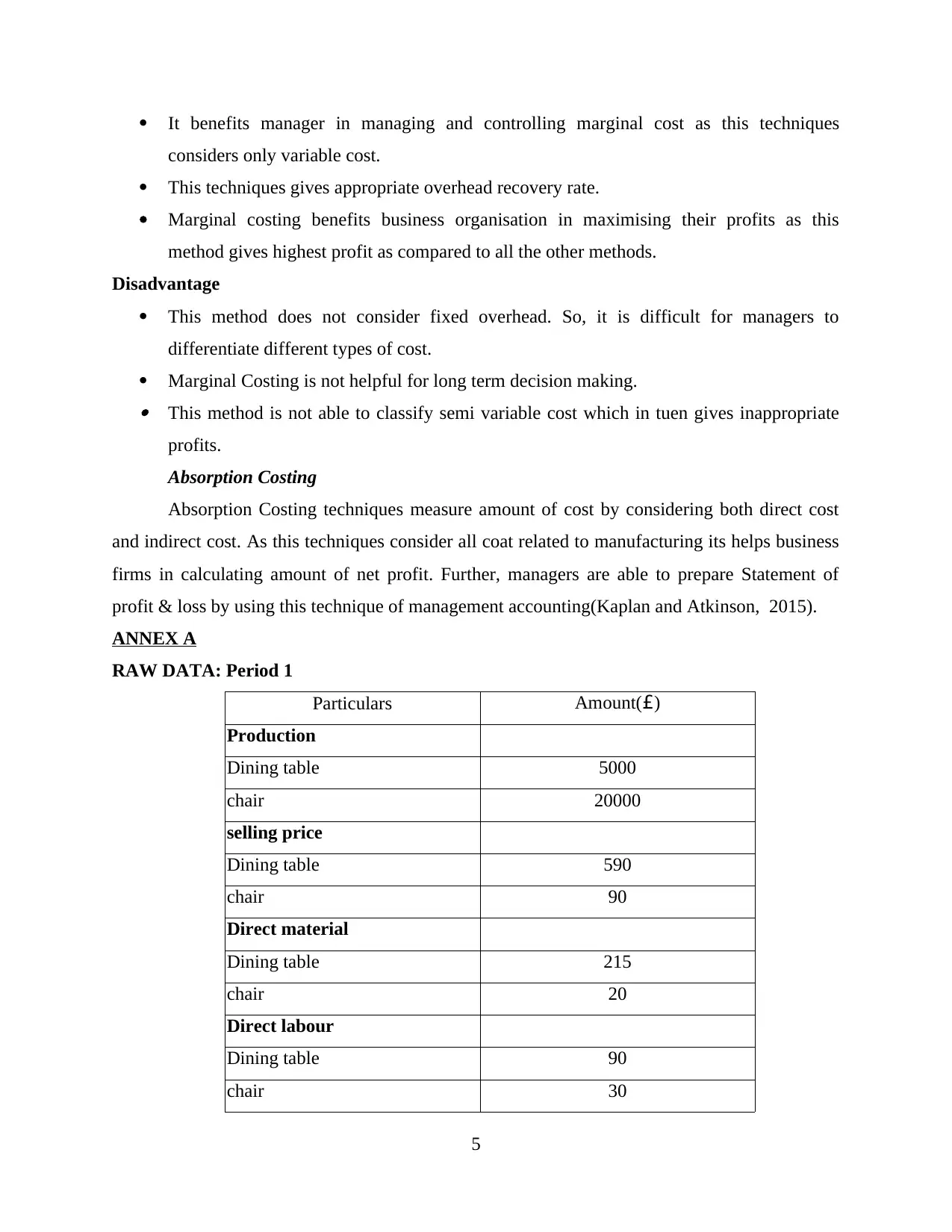
It benefits manager in managing and controlling marginal cost as this techniques
considers only variable cost.
This techniques gives appropriate overhead recovery rate.
Marginal costing benefits business organisation in maximising their profits as this
method gives highest profit as compared to all the other methods.
Disadvantage
This method does not consider fixed overhead. So, it is difficult for managers to
differentiate different types of cost.
Marginal Costing is not helpful for long term decision making. This method is not able to classify semi variable cost which in tuen gives inappropriate
profits.
Absorption Costing
Absorption Costing techniques measure amount of cost by considering both direct cost
and indirect cost. As this techniques consider all coat related to manufacturing its helps business
firms in calculating amount of net profit. Further, managers are able to prepare Statement of
profit & loss by using this technique of management accounting(Kaplan and Atkinson, 2015).
ANNEX A
RAW DATA: Period 1
Particulars Amount(£)
Production
Dining table 5000
chair 20000
selling price
Dining table 590
chair 90
Direct material
Dining table 215
chair 20
Direct labour
Dining table 90
chair 30
5
considers only variable cost.
This techniques gives appropriate overhead recovery rate.
Marginal costing benefits business organisation in maximising their profits as this
method gives highest profit as compared to all the other methods.
Disadvantage
This method does not consider fixed overhead. So, it is difficult for managers to
differentiate different types of cost.
Marginal Costing is not helpful for long term decision making. This method is not able to classify semi variable cost which in tuen gives inappropriate
profits.
Absorption Costing
Absorption Costing techniques measure amount of cost by considering both direct cost
and indirect cost. As this techniques consider all coat related to manufacturing its helps business
firms in calculating amount of net profit. Further, managers are able to prepare Statement of
profit & loss by using this technique of management accounting(Kaplan and Atkinson, 2015).
ANNEX A
RAW DATA: Period 1
Particulars Amount(£)
Production
Dining table 5000
chair 20000
selling price
Dining table 590
chair 90
Direct material
Dining table 215
chair 20
Direct labour
Dining table 90
chair 30
5
Paraphrase This Document
Need a fresh take? Get an instant paraphrase of this document with our AI Paraphraser
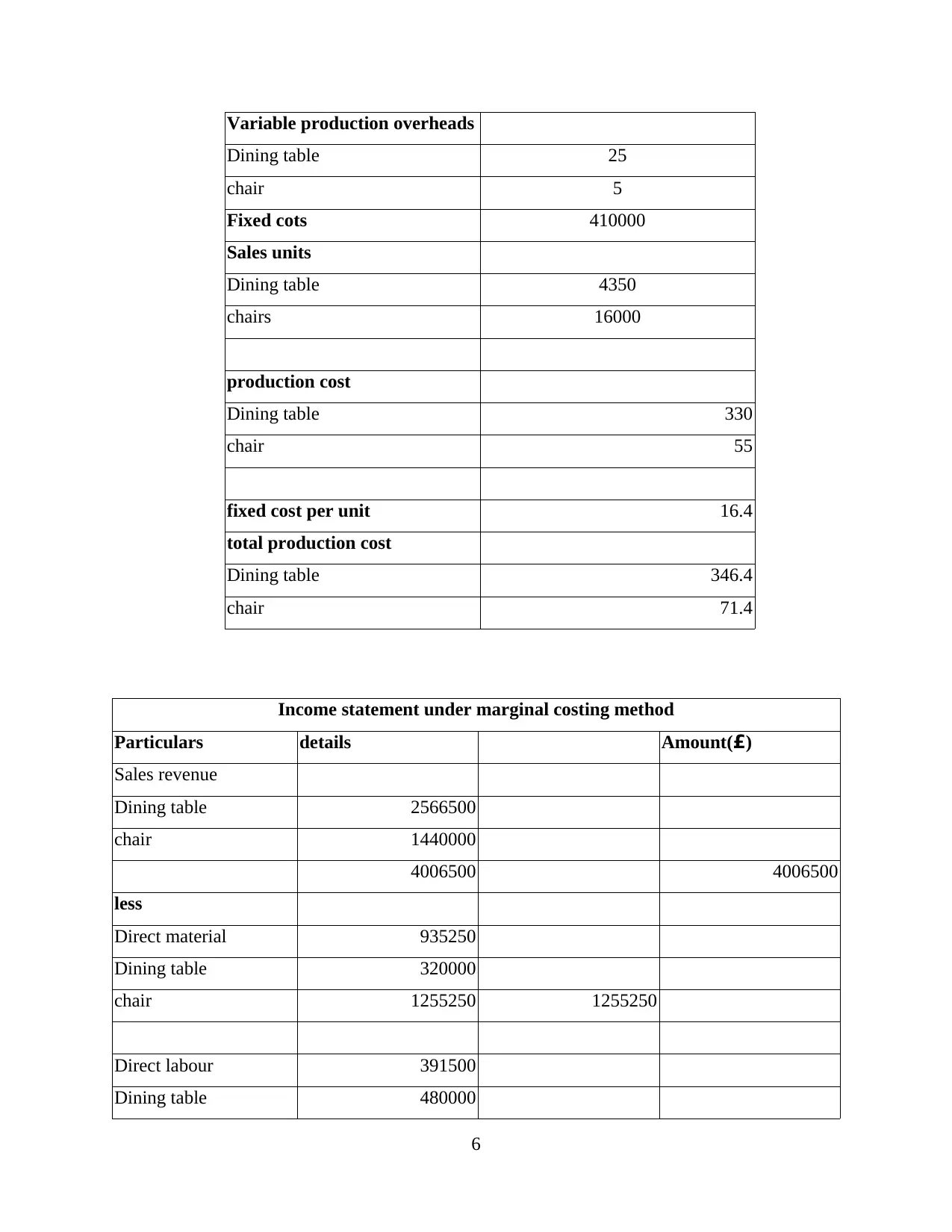
Variable production overheads
Dining table 25
chair 5
Fixed cots 410000
Sales units
Dining table 4350
chairs 16000
production cost
Dining table 330
chair 55
fixed cost per unit 16.4
total production cost
Dining table 346.4
chair 71.4
Income statement under marginal costing method
Particulars details Amount(£)
Sales revenue
Dining table 2566500
chair 1440000
4006500 4006500
less
Direct material 935250
Dining table 320000
chair 1255250 1255250
Direct labour 391500
Dining table 480000
6
Dining table 25
chair 5
Fixed cots 410000
Sales units
Dining table 4350
chairs 16000
production cost
Dining table 330
chair 55
fixed cost per unit 16.4
total production cost
Dining table 346.4
chair 71.4
Income statement under marginal costing method
Particulars details Amount(£)
Sales revenue
Dining table 2566500
chair 1440000
4006500 4006500
less
Direct material 935250
Dining table 320000
chair 1255250 1255250
Direct labour 391500
Dining table 480000
6
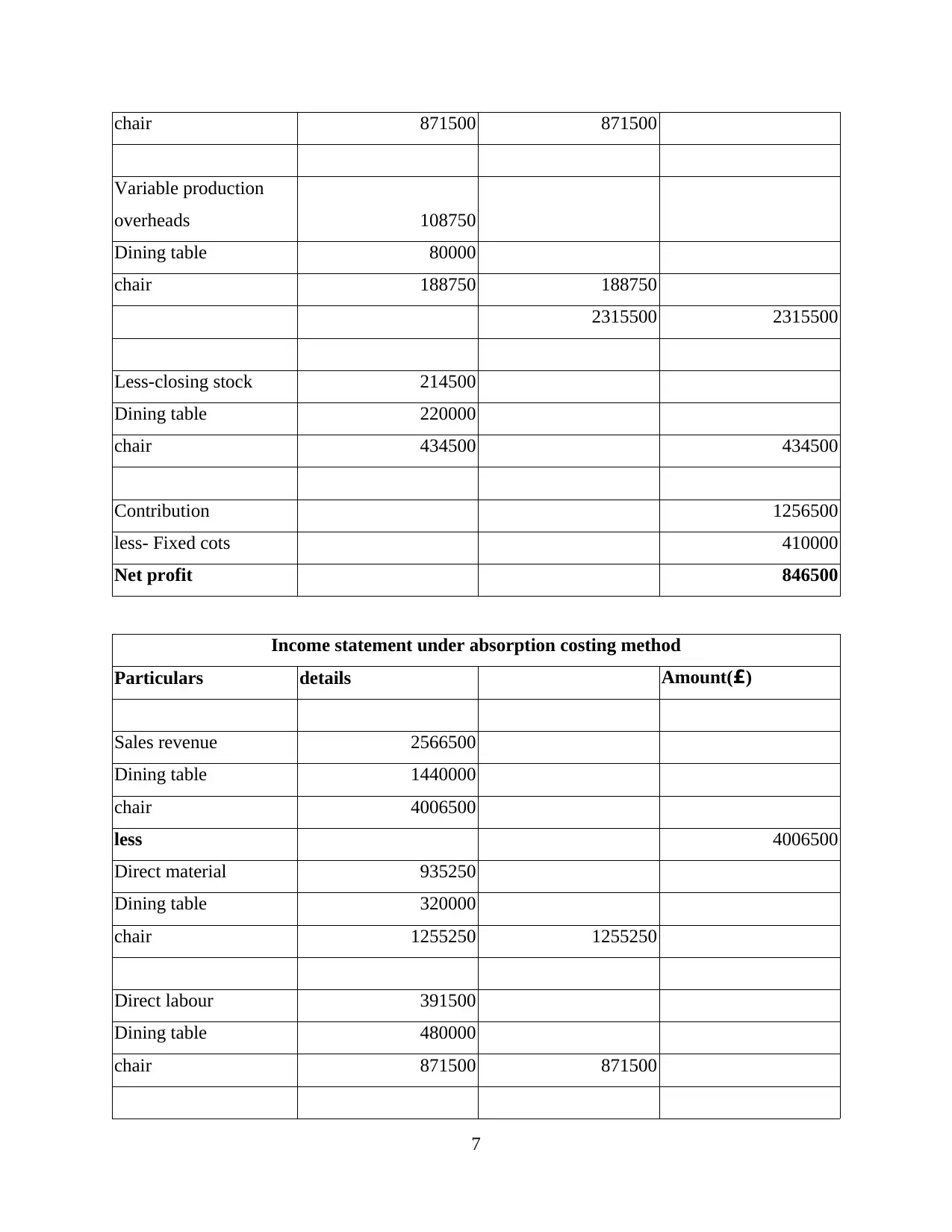
chair 871500 871500
Variable production
overheads 108750
Dining table 80000
chair 188750 188750
2315500 2315500
Less-closing stock 214500
Dining table 220000
chair 434500 434500
Contribution 1256500
less- Fixed cots 410000
Net profit 846500
Income statement under absorption costing method
Particulars details Amount(£)
Sales revenue 2566500
Dining table 1440000
chair 4006500
less 4006500
Direct material 935250
Dining table 320000
chair 1255250 1255250
Direct labour 391500
Dining table 480000
chair 871500 871500
7
Variable production
overheads 108750
Dining table 80000
chair 188750 188750
2315500 2315500
Less-closing stock 214500
Dining table 220000
chair 434500 434500
Contribution 1256500
less- Fixed cots 410000
Net profit 846500
Income statement under absorption costing method
Particulars details Amount(£)
Sales revenue 2566500
Dining table 1440000
chair 4006500
less 4006500
Direct material 935250
Dining table 320000
chair 1255250 1255250
Direct labour 391500
Dining table 480000
chair 871500 871500
7
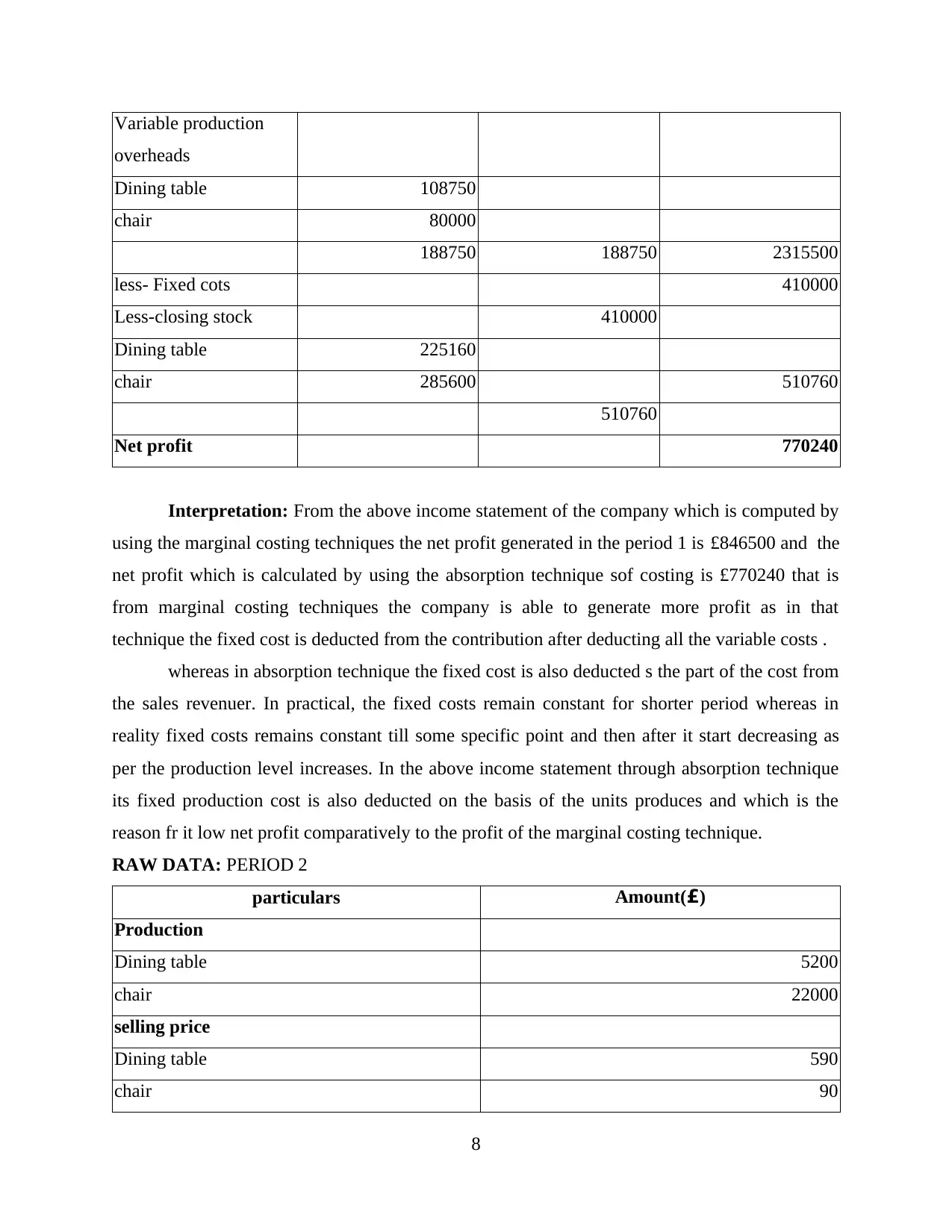
Variable production
overheads
Dining table 108750
chair 80000
188750 188750 2315500
less- Fixed cots 410000
Less-closing stock 410000
Dining table 225160
chair 285600 510760
510760
Net profit 770240
Interpretation: From the above income statement of the company which is computed by
using the marginal costing techniques the net profit generated in the period 1 is £846500 and the
net profit which is calculated by using the absorption technique sof costing is £770240 that is
from marginal costing techniques the company is able to generate more profit as in that
technique the fixed cost is deducted from the contribution after deducting all the variable costs .
whereas in absorption technique the fixed cost is also deducted s the part of the cost from
the sales revenuer. In practical, the fixed costs remain constant for shorter period whereas in
reality fixed costs remains constant till some specific point and then after it start decreasing as
per the production level increases. In the above income statement through absorption technique
its fixed production cost is also deducted on the basis of the units produces and which is the
reason fr it low net profit comparatively to the profit of the marginal costing technique.
RAW DATA: PERIOD 2
particulars Amount(£)
Production
Dining table 5200
chair 22000
selling price
Dining table 590
chair 90
8
overheads
Dining table 108750
chair 80000
188750 188750 2315500
less- Fixed cots 410000
Less-closing stock 410000
Dining table 225160
chair 285600 510760
510760
Net profit 770240
Interpretation: From the above income statement of the company which is computed by
using the marginal costing techniques the net profit generated in the period 1 is £846500 and the
net profit which is calculated by using the absorption technique sof costing is £770240 that is
from marginal costing techniques the company is able to generate more profit as in that
technique the fixed cost is deducted from the contribution after deducting all the variable costs .
whereas in absorption technique the fixed cost is also deducted s the part of the cost from
the sales revenuer. In practical, the fixed costs remain constant for shorter period whereas in
reality fixed costs remains constant till some specific point and then after it start decreasing as
per the production level increases. In the above income statement through absorption technique
its fixed production cost is also deducted on the basis of the units produces and which is the
reason fr it low net profit comparatively to the profit of the marginal costing technique.
RAW DATA: PERIOD 2
particulars Amount(£)
Production
Dining table 5200
chair 22000
selling price
Dining table 590
chair 90
8
Secure Best Marks with AI Grader
Need help grading? Try our AI Grader for instant feedback on your assignments.
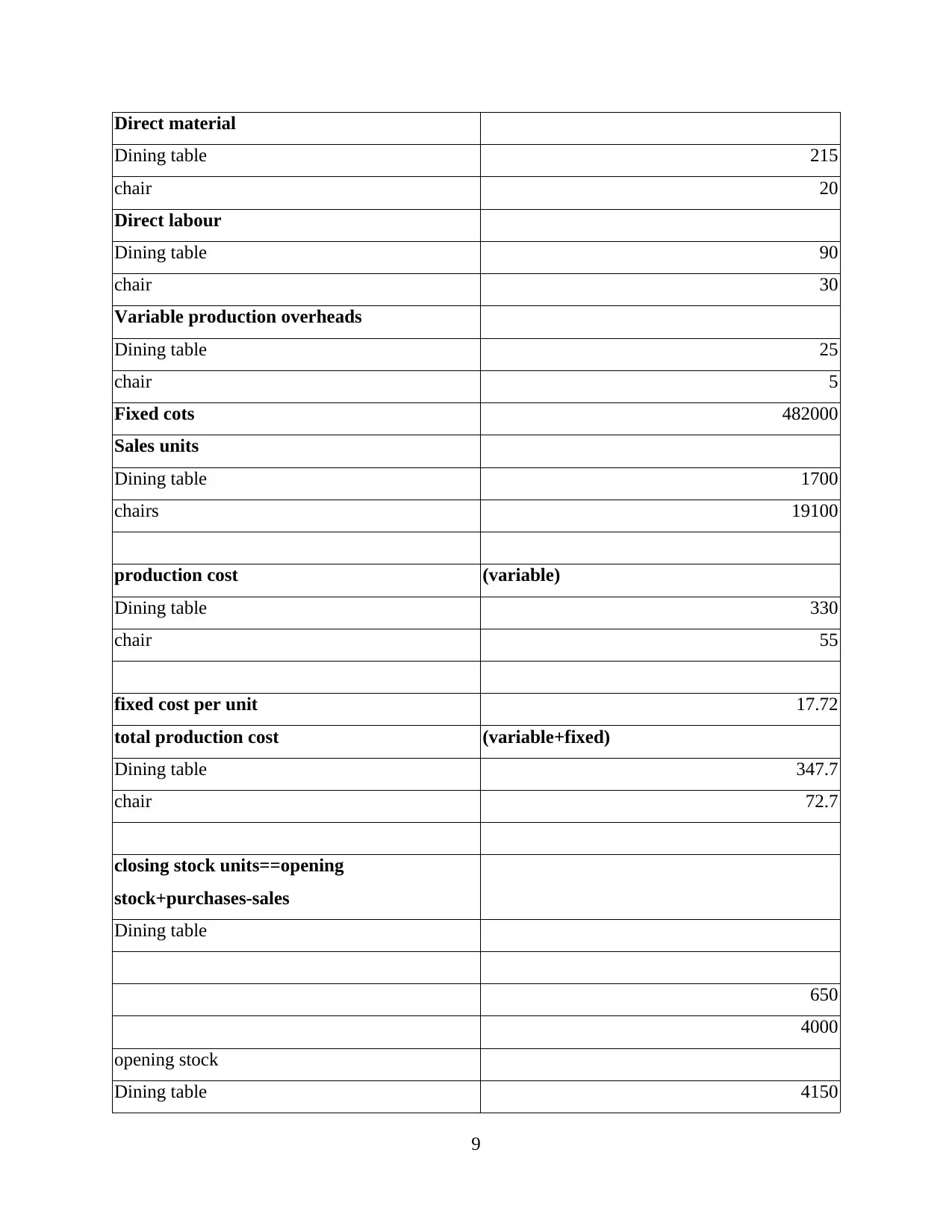
Direct material
Dining table 215
chair 20
Direct labour
Dining table 90
chair 30
Variable production overheads
Dining table 25
chair 5
Fixed cots 482000
Sales units
Dining table 1700
chairs 19100
production cost (variable)
Dining table 330
chair 55
fixed cost per unit 17.72
total production cost (variable+fixed)
Dining table 347.7
chair 72.7
closing stock units==opening
stock+purchases-sales
Dining table
650
4000
opening stock
Dining table 4150
9
Dining table 215
chair 20
Direct labour
Dining table 90
chair 30
Variable production overheads
Dining table 25
chair 5
Fixed cots 482000
Sales units
Dining table 1700
chairs 19100
production cost (variable)
Dining table 330
chair 55
fixed cost per unit 17.72
total production cost (variable+fixed)
Dining table 347.7
chair 72.7
closing stock units==opening
stock+purchases-sales
Dining table
650
4000
opening stock
Dining table 4150
9
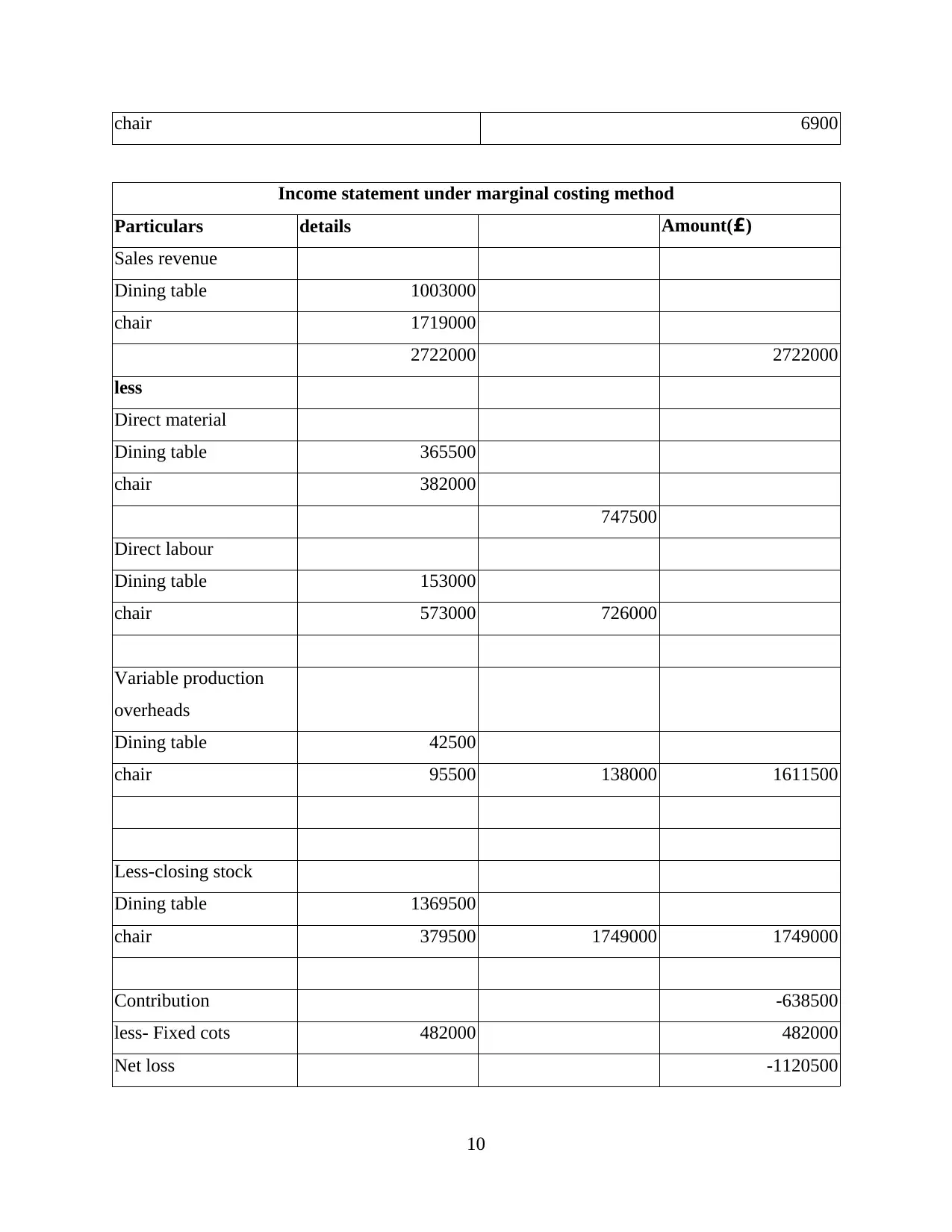
chair 6900
Income statement under marginal costing method
Particulars details Amount(£)
Sales revenue
Dining table 1003000
chair 1719000
2722000 2722000
less
Direct material
Dining table 365500
chair 382000
747500
Direct labour
Dining table 153000
chair 573000 726000
Variable production
overheads
Dining table 42500
chair 95500 138000 1611500
Less-closing stock
Dining table 1369500
chair 379500 1749000 1749000
Contribution -638500
less- Fixed cots 482000 482000
Net loss -1120500
10
Income statement under marginal costing method
Particulars details Amount(£)
Sales revenue
Dining table 1003000
chair 1719000
2722000 2722000
less
Direct material
Dining table 365500
chair 382000
747500
Direct labour
Dining table 153000
chair 573000 726000
Variable production
overheads
Dining table 42500
chair 95500 138000 1611500
Less-closing stock
Dining table 1369500
chair 379500 1749000 1749000
Contribution -638500
less- Fixed cots 482000 482000
Net loss -1120500
10
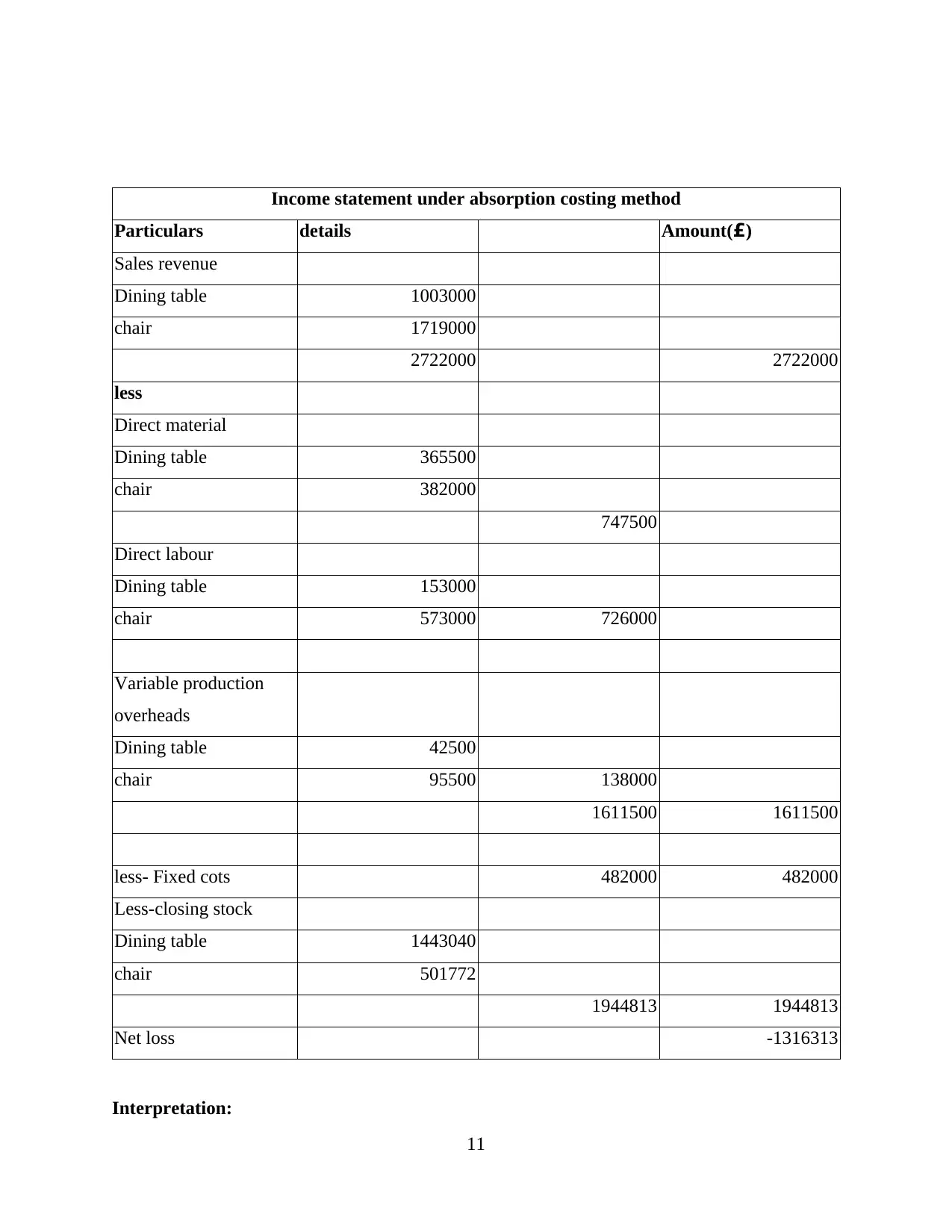
Income statement under absorption costing method
Particulars details Amount(£)
Sales revenue
Dining table 1003000
chair 1719000
2722000 2722000
less
Direct material
Dining table 365500
chair 382000
747500
Direct labour
Dining table 153000
chair 573000 726000
Variable production
overheads
Dining table 42500
chair 95500 138000
1611500 1611500
less- Fixed cots 482000 482000
Less-closing stock
Dining table 1443040
chair 501772
1944813 1944813
Net loss -1316313
Interpretation:
11
Particulars details Amount(£)
Sales revenue
Dining table 1003000
chair 1719000
2722000 2722000
less
Direct material
Dining table 365500
chair 382000
747500
Direct labour
Dining table 153000
chair 573000 726000
Variable production
overheads
Dining table 42500
chair 95500 138000
1611500 1611500
less- Fixed cots 482000 482000
Less-closing stock
Dining table 1443040
chair 501772
1944813 1944813
Net loss -1316313
Interpretation:
11
Paraphrase This Document
Need a fresh take? Get an instant paraphrase of this document with our AI Paraphraser
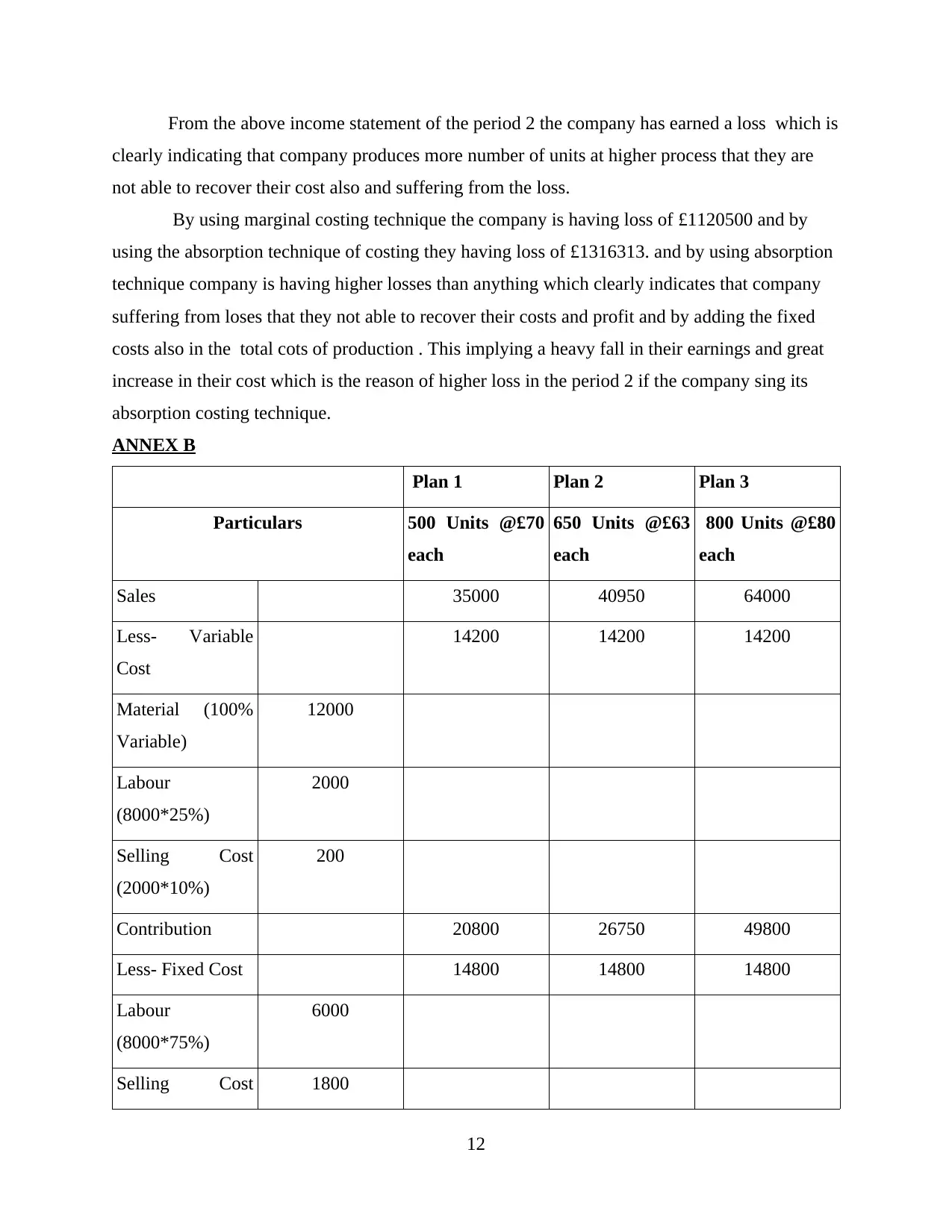
From the above income statement of the period 2 the company has earned a loss which is
clearly indicating that company produces more number of units at higher process that they are
not able to recover their cost also and suffering from the loss.
By using marginal costing technique the company is having loss of £1120500 and by
using the absorption technique of costing they having loss of £1316313. and by using absorption
technique company is having higher losses than anything which clearly indicates that company
suffering from loses that they not able to recover their costs and profit and by adding the fixed
costs also in the total cots of production . This implying a heavy fall in their earnings and great
increase in their cost which is the reason of higher loss in the period 2 if the company sing its
absorption costing technique.
ANNEX B
Plan 1 Plan 2 Plan 3
Particulars 500 Units @£70
each
650 Units @£63
each
800 Units @£80
each
Sales 35000 40950 64000
Less- Variable
Cost
14200 14200 14200
Material (100%
Variable)
12000
Labour
(8000*25%)
2000
Selling Cost
(2000*10%)
200
Contribution 20800 26750 49800
Less- Fixed Cost 14800 14800 14800
Labour
(8000*75%)
6000
Selling Cost 1800
12
clearly indicating that company produces more number of units at higher process that they are
not able to recover their cost also and suffering from the loss.
By using marginal costing technique the company is having loss of £1120500 and by
using the absorption technique of costing they having loss of £1316313. and by using absorption
technique company is having higher losses than anything which clearly indicates that company
suffering from loses that they not able to recover their costs and profit and by adding the fixed
costs also in the total cots of production . This implying a heavy fall in their earnings and great
increase in their cost which is the reason of higher loss in the period 2 if the company sing its
absorption costing technique.
ANNEX B
Plan 1 Plan 2 Plan 3
Particulars 500 Units @£70
each
650 Units @£63
each
800 Units @£80
each
Sales 35000 40950 64000
Less- Variable
Cost
14200 14200 14200
Material (100%
Variable)
12000
Labour
(8000*25%)
2000
Selling Cost
(2000*10%)
200
Contribution 20800 26750 49800
Less- Fixed Cost 14800 14800 14800
Labour
(8000*75%)
6000
Selling Cost 1800
12
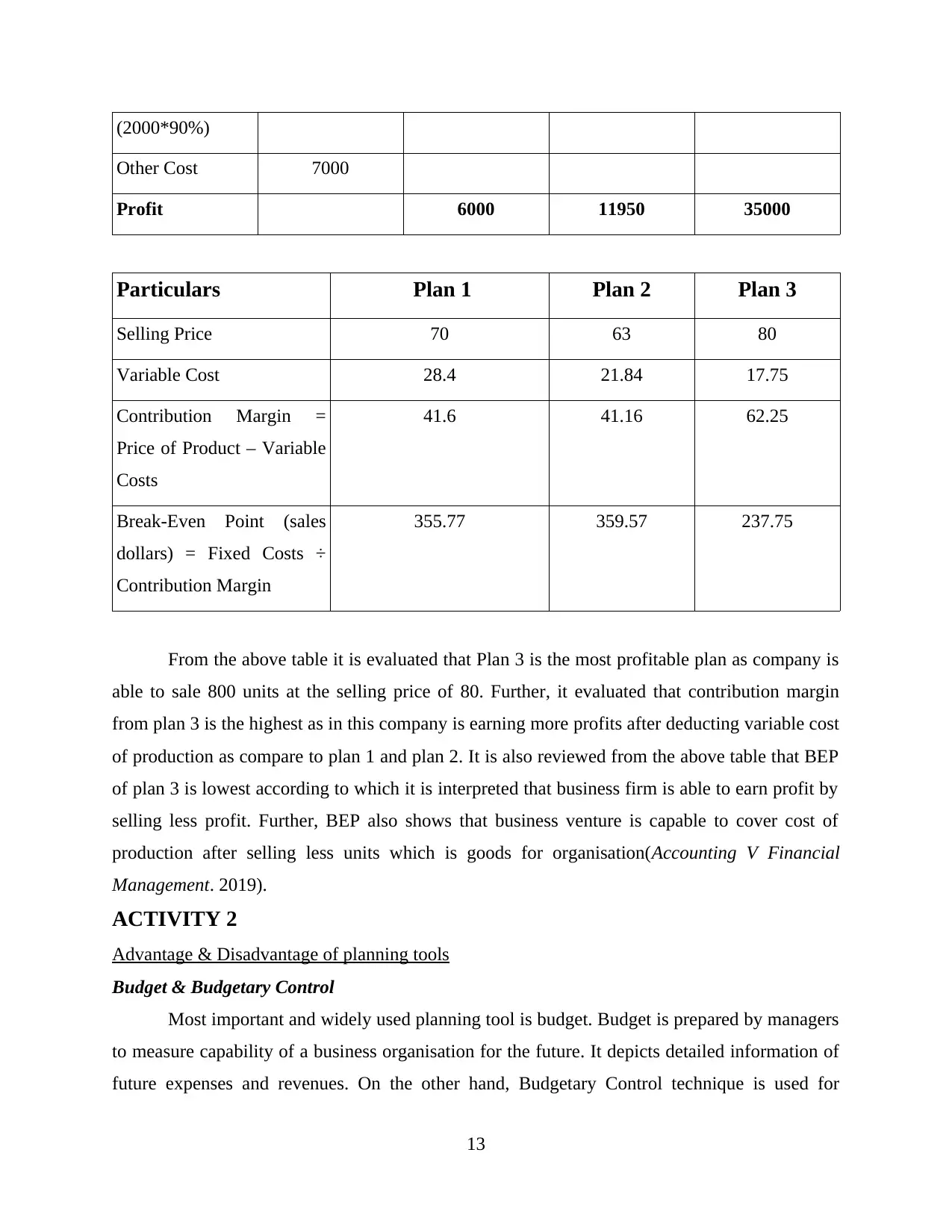
(2000*90%)
Other Cost 7000
Profit 6000 11950 35000
Particulars Plan 1 Plan 2 Plan 3
Selling Price 70 63 80
Variable Cost 28.4 21.84 17.75
Contribution Margin =
Price of Product – Variable
Costs
41.6 41.16 62.25
Break-Even Point (sales
dollars) = Fixed Costs ÷
Contribution Margin
355.77 359.57 237.75
From the above table it is evaluated that Plan 3 is the most profitable plan as company is
able to sale 800 units at the selling price of 80. Further, it evaluated that contribution margin
from plan 3 is the highest as in this company is earning more profits after deducting variable cost
of production as compare to plan 1 and plan 2. It is also reviewed from the above table that BEP
of plan 3 is lowest according to which it is interpreted that business firm is able to earn profit by
selling less profit. Further, BEP also shows that business venture is capable to cover cost of
production after selling less units which is goods for organisation(Accounting V Financial
Management. 2019).
ACTIVITY 2
Advantage & Disadvantage of planning tools
Budget & Budgetary Control
Most important and widely used planning tool is budget. Budget is prepared by managers
to measure capability of a business organisation for the future. It depicts detailed information of
future expenses and revenues. On the other hand, Budgetary Control technique is used for
13
Other Cost 7000
Profit 6000 11950 35000
Particulars Plan 1 Plan 2 Plan 3
Selling Price 70 63 80
Variable Cost 28.4 21.84 17.75
Contribution Margin =
Price of Product – Variable
Costs
41.6 41.16 62.25
Break-Even Point (sales
dollars) = Fixed Costs ÷
Contribution Margin
355.77 359.57 237.75
From the above table it is evaluated that Plan 3 is the most profitable plan as company is
able to sale 800 units at the selling price of 80. Further, it evaluated that contribution margin
from plan 3 is the highest as in this company is earning more profits after deducting variable cost
of production as compare to plan 1 and plan 2. It is also reviewed from the above table that BEP
of plan 3 is lowest according to which it is interpreted that business firm is able to earn profit by
selling less profit. Further, BEP also shows that business venture is capable to cover cost of
production after selling less units which is goods for organisation(Accounting V Financial
Management. 2019).
ACTIVITY 2
Advantage & Disadvantage of planning tools
Budget & Budgetary Control
Most important and widely used planning tool is budget. Budget is prepared by managers
to measure capability of a business organisation for the future. It depicts detailed information of
future expenses and revenues. On the other hand, Budgetary Control technique is used for
13
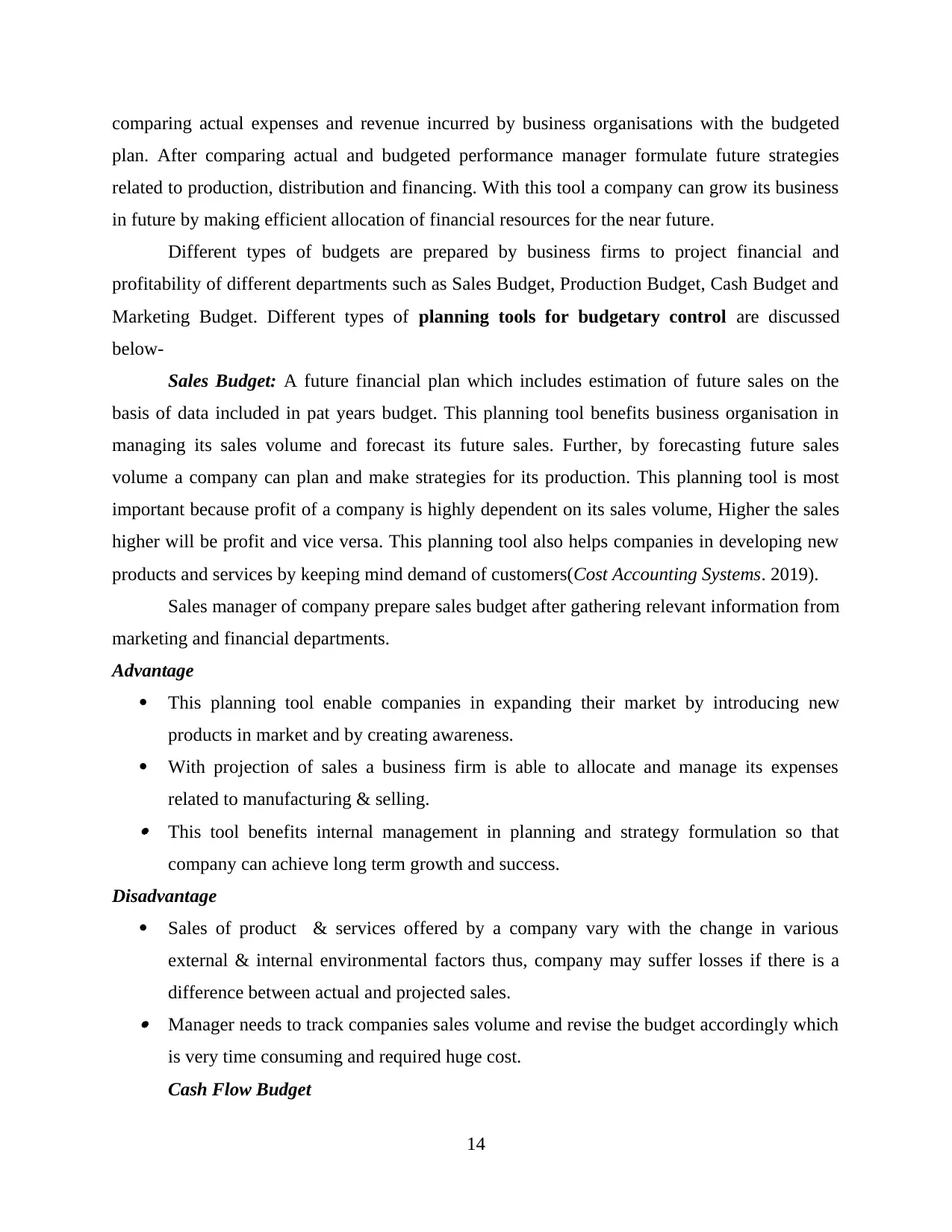
comparing actual expenses and revenue incurred by business organisations with the budgeted
plan. After comparing actual and budgeted performance manager formulate future strategies
related to production, distribution and financing. With this tool a company can grow its business
in future by making efficient allocation of financial resources for the near future.
Different types of budgets are prepared by business firms to project financial and
profitability of different departments such as Sales Budget, Production Budget, Cash Budget and
Marketing Budget. Different types of planning tools for budgetary control are discussed
below-
Sales Budget: A future financial plan which includes estimation of future sales on the
basis of data included in pat years budget. This planning tool benefits business organisation in
managing its sales volume and forecast its future sales. Further, by forecasting future sales
volume a company can plan and make strategies for its production. This planning tool is most
important because profit of a company is highly dependent on its sales volume, Higher the sales
higher will be profit and vice versa. This planning tool also helps companies in developing new
products and services by keeping mind demand of customers(Cost Accounting Systems. 2019).
Sales manager of company prepare sales budget after gathering relevant information from
marketing and financial departments.
Advantage
This planning tool enable companies in expanding their market by introducing new
products in market and by creating awareness.
With projection of sales a business firm is able to allocate and manage its expenses
related to manufacturing & selling. This tool benefits internal management in planning and strategy formulation so that
company can achieve long term growth and success.
Disadvantage
Sales of product & services offered by a company vary with the change in various
external & internal environmental factors thus, company may suffer losses if there is a
difference between actual and projected sales. Manager needs to track companies sales volume and revise the budget accordingly which
is very time consuming and required huge cost.
Cash Flow Budget
14
plan. After comparing actual and budgeted performance manager formulate future strategies
related to production, distribution and financing. With this tool a company can grow its business
in future by making efficient allocation of financial resources for the near future.
Different types of budgets are prepared by business firms to project financial and
profitability of different departments such as Sales Budget, Production Budget, Cash Budget and
Marketing Budget. Different types of planning tools for budgetary control are discussed
below-
Sales Budget: A future financial plan which includes estimation of future sales on the
basis of data included in pat years budget. This planning tool benefits business organisation in
managing its sales volume and forecast its future sales. Further, by forecasting future sales
volume a company can plan and make strategies for its production. This planning tool is most
important because profit of a company is highly dependent on its sales volume, Higher the sales
higher will be profit and vice versa. This planning tool also helps companies in developing new
products and services by keeping mind demand of customers(Cost Accounting Systems. 2019).
Sales manager of company prepare sales budget after gathering relevant information from
marketing and financial departments.
Advantage
This planning tool enable companies in expanding their market by introducing new
products in market and by creating awareness.
With projection of sales a business firm is able to allocate and manage its expenses
related to manufacturing & selling. This tool benefits internal management in planning and strategy formulation so that
company can achieve long term growth and success.
Disadvantage
Sales of product & services offered by a company vary with the change in various
external & internal environmental factors thus, company may suffer losses if there is a
difference between actual and projected sales. Manager needs to track companies sales volume and revise the budget accordingly which
is very time consuming and required huge cost.
Cash Flow Budget
14
Secure Best Marks with AI Grader
Need help grading? Try our AI Grader for instant feedback on your assignments.
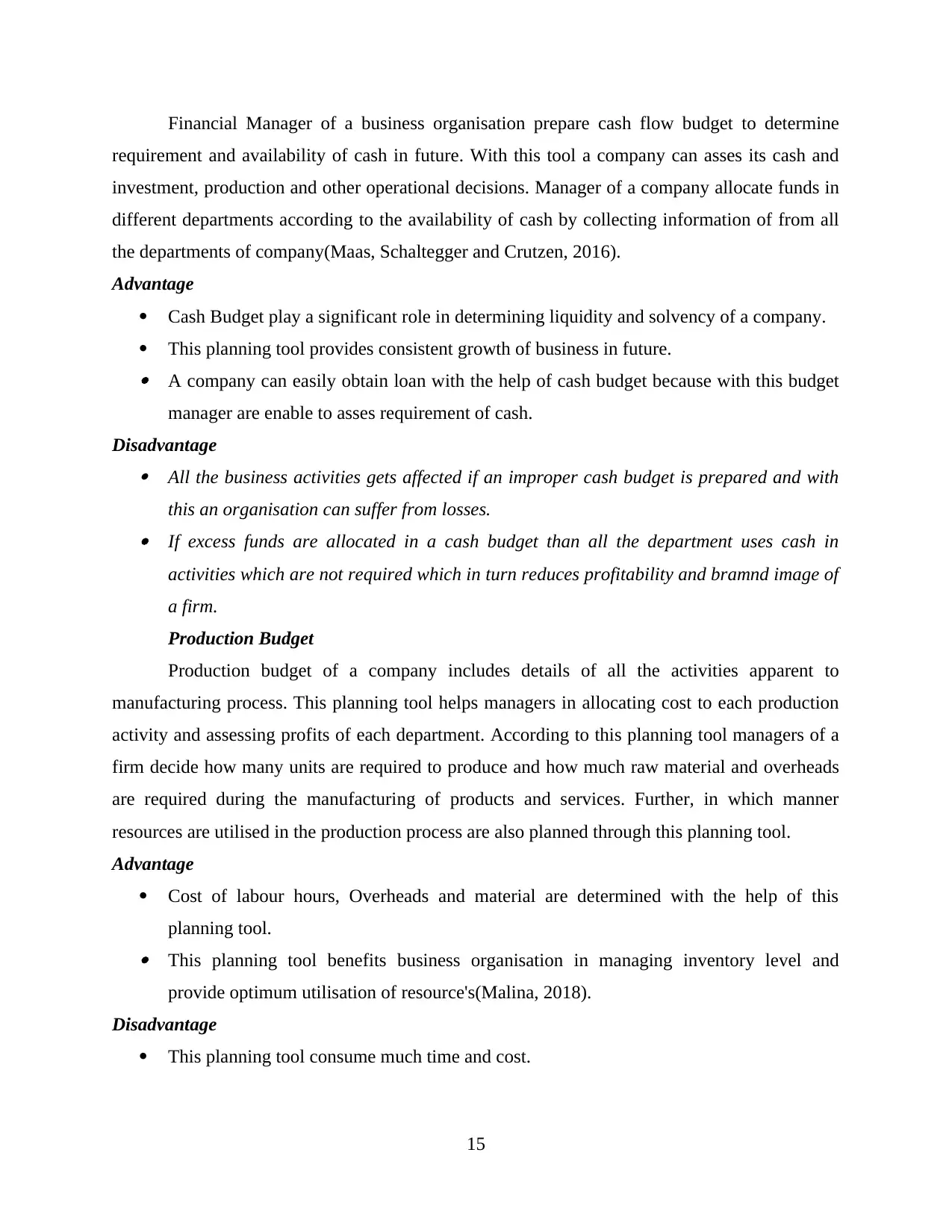
Financial Manager of a business organisation prepare cash flow budget to determine
requirement and availability of cash in future. With this tool a company can asses its cash and
investment, production and other operational decisions. Manager of a company allocate funds in
different departments according to the availability of cash by collecting information of from all
the departments of company(Maas, Schaltegger and Crutzen, 2016).
Advantage
Cash Budget play a significant role in determining liquidity and solvency of a company.
This planning tool provides consistent growth of business in future. A company can easily obtain loan with the help of cash budget because with this budget
manager are enable to asses requirement of cash.
Disadvantage All the business activities gets affected if an improper cash budget is prepared and with
this an organisation can suffer from losses. If excess funds are allocated in a cash budget than all the department uses cash in
activities which are not required which in turn reduces profitability and bramnd image of
a firm.
Production Budget
Production budget of a company includes details of all the activities apparent to
manufacturing process. This planning tool helps managers in allocating cost to each production
activity and assessing profits of each department. According to this planning tool managers of a
firm decide how many units are required to produce and how much raw material and overheads
are required during the manufacturing of products and services. Further, in which manner
resources are utilised in the production process are also planned through this planning tool.
Advantage
Cost of labour hours, Overheads and material are determined with the help of this
planning tool. This planning tool benefits business organisation in managing inventory level and
provide optimum utilisation of resource's(Malina, 2018).
Disadvantage
This planning tool consume much time and cost.
15
requirement and availability of cash in future. With this tool a company can asses its cash and
investment, production and other operational decisions. Manager of a company allocate funds in
different departments according to the availability of cash by collecting information of from all
the departments of company(Maas, Schaltegger and Crutzen, 2016).
Advantage
Cash Budget play a significant role in determining liquidity and solvency of a company.
This planning tool provides consistent growth of business in future. A company can easily obtain loan with the help of cash budget because with this budget
manager are enable to asses requirement of cash.
Disadvantage All the business activities gets affected if an improper cash budget is prepared and with
this an organisation can suffer from losses. If excess funds are allocated in a cash budget than all the department uses cash in
activities which are not required which in turn reduces profitability and bramnd image of
a firm.
Production Budget
Production budget of a company includes details of all the activities apparent to
manufacturing process. This planning tool helps managers in allocating cost to each production
activity and assessing profits of each department. According to this planning tool managers of a
firm decide how many units are required to produce and how much raw material and overheads
are required during the manufacturing of products and services. Further, in which manner
resources are utilised in the production process are also planned through this planning tool.
Advantage
Cost of labour hours, Overheads and material are determined with the help of this
planning tool. This planning tool benefits business organisation in managing inventory level and
provide optimum utilisation of resource's(Malina, 2018).
Disadvantage
This planning tool consume much time and cost.
15
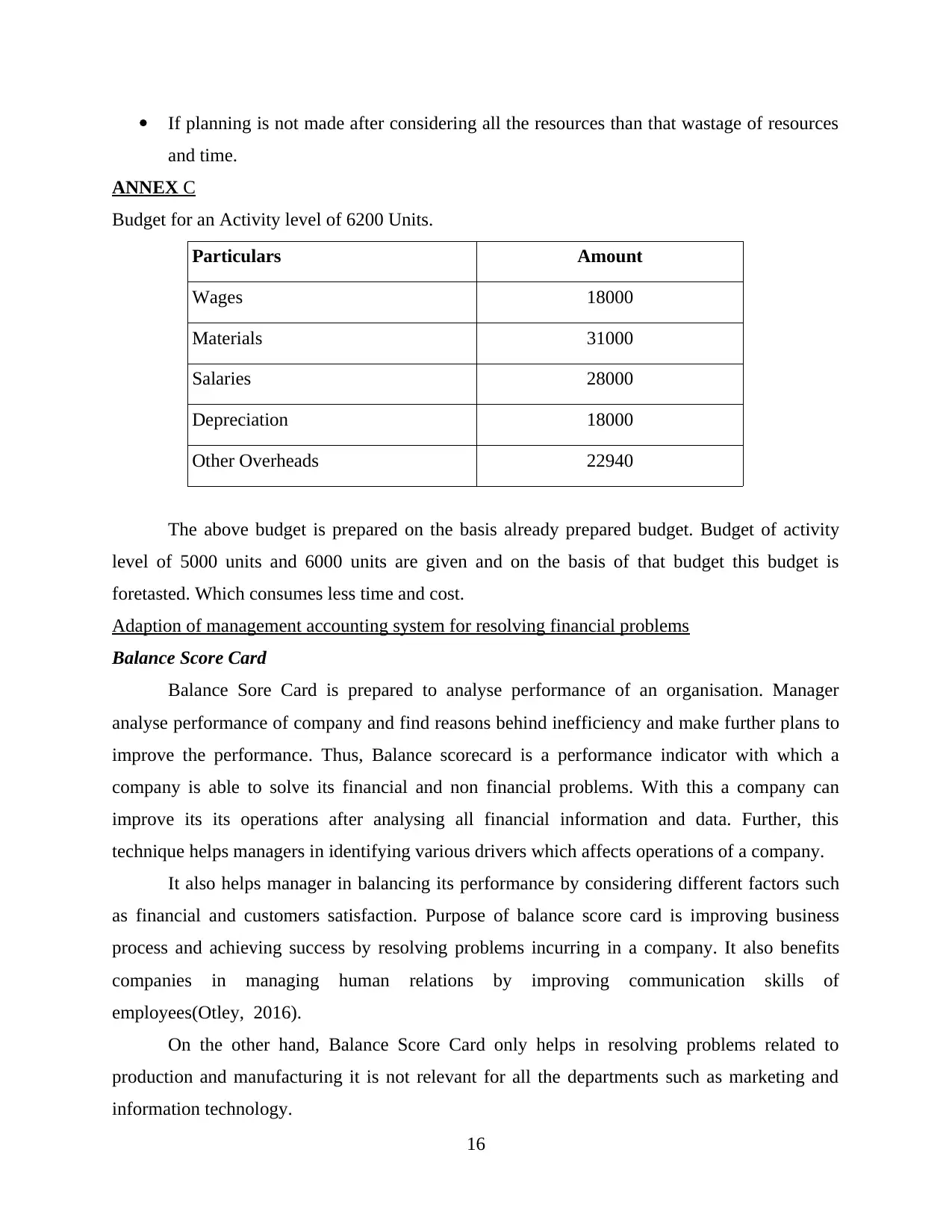
If planning is not made after considering all the resources than that wastage of resources
and time.
ANNEX C
Budget for an Activity level of 6200 Units.
Particulars Amount
Wages 18000
Materials 31000
Salaries 28000
Depreciation 18000
Other Overheads 22940
The above budget is prepared on the basis already prepared budget. Budget of activity
level of 5000 units and 6000 units are given and on the basis of that budget this budget is
foretasted. Which consumes less time and cost.
Adaption of management accounting system for resolving financial problems
Balance Score Card
Balance Sore Card is prepared to analyse performance of an organisation. Manager
analyse performance of company and find reasons behind inefficiency and make further plans to
improve the performance. Thus, Balance scorecard is a performance indicator with which a
company is able to solve its financial and non financial problems. With this a company can
improve its its operations after analysing all financial information and data. Further, this
technique helps managers in identifying various drivers which affects operations of a company.
It also helps manager in balancing its performance by considering different factors such
as financial and customers satisfaction. Purpose of balance score card is improving business
process and achieving success by resolving problems incurring in a company. It also benefits
companies in managing human relations by improving communication skills of
employees(Otley, 2016).
On the other hand, Balance Score Card only helps in resolving problems related to
production and manufacturing it is not relevant for all the departments such as marketing and
information technology.
16
and time.
ANNEX C
Budget for an Activity level of 6200 Units.
Particulars Amount
Wages 18000
Materials 31000
Salaries 28000
Depreciation 18000
Other Overheads 22940
The above budget is prepared on the basis already prepared budget. Budget of activity
level of 5000 units and 6000 units are given and on the basis of that budget this budget is
foretasted. Which consumes less time and cost.
Adaption of management accounting system for resolving financial problems
Balance Score Card
Balance Sore Card is prepared to analyse performance of an organisation. Manager
analyse performance of company and find reasons behind inefficiency and make further plans to
improve the performance. Thus, Balance scorecard is a performance indicator with which a
company is able to solve its financial and non financial problems. With this a company can
improve its its operations after analysing all financial information and data. Further, this
technique helps managers in identifying various drivers which affects operations of a company.
It also helps manager in balancing its performance by considering different factors such
as financial and customers satisfaction. Purpose of balance score card is improving business
process and achieving success by resolving problems incurring in a company. It also benefits
companies in managing human relations by improving communication skills of
employees(Otley, 2016).
On the other hand, Balance Score Card only helps in resolving problems related to
production and manufacturing it is not relevant for all the departments such as marketing and
information technology.
16
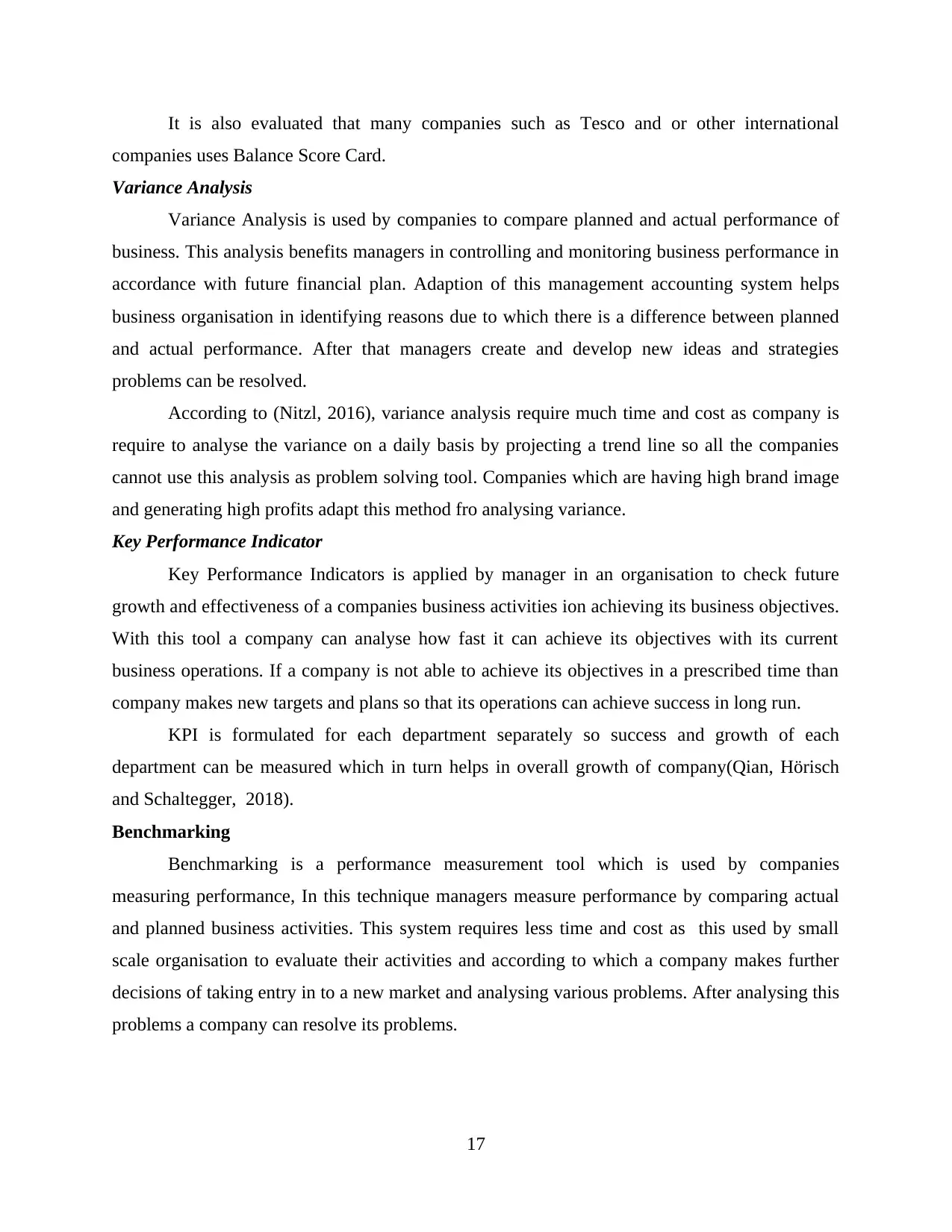
It is also evaluated that many companies such as Tesco and or other international
companies uses Balance Score Card.
Variance Analysis
Variance Analysis is used by companies to compare planned and actual performance of
business. This analysis benefits managers in controlling and monitoring business performance in
accordance with future financial plan. Adaption of this management accounting system helps
business organisation in identifying reasons due to which there is a difference between planned
and actual performance. After that managers create and develop new ideas and strategies
problems can be resolved.
According to (Nitzl, 2016), variance analysis require much time and cost as company is
require to analyse the variance on a daily basis by projecting a trend line so all the companies
cannot use this analysis as problem solving tool. Companies which are having high brand image
and generating high profits adapt this method fro analysing variance.
Key Performance Indicator
Key Performance Indicators is applied by manager in an organisation to check future
growth and effectiveness of a companies business activities ion achieving its business objectives.
With this tool a company can analyse how fast it can achieve its objectives with its current
business operations. If a company is not able to achieve its objectives in a prescribed time than
company makes new targets and plans so that its operations can achieve success in long run.
KPI is formulated for each department separately so success and growth of each
department can be measured which in turn helps in overall growth of company(Qian, Hörisch
and Schaltegger, 2018).
Benchmarking
Benchmarking is a performance measurement tool which is used by companies
measuring performance, In this technique managers measure performance by comparing actual
and planned business activities. This system requires less time and cost as this used by small
scale organisation to evaluate their activities and according to which a company makes further
decisions of taking entry in to a new market and analysing various problems. After analysing this
problems a company can resolve its problems.
17
companies uses Balance Score Card.
Variance Analysis
Variance Analysis is used by companies to compare planned and actual performance of
business. This analysis benefits managers in controlling and monitoring business performance in
accordance with future financial plan. Adaption of this management accounting system helps
business organisation in identifying reasons due to which there is a difference between planned
and actual performance. After that managers create and develop new ideas and strategies
problems can be resolved.
According to (Nitzl, 2016), variance analysis require much time and cost as company is
require to analyse the variance on a daily basis by projecting a trend line so all the companies
cannot use this analysis as problem solving tool. Companies which are having high brand image
and generating high profits adapt this method fro analysing variance.
Key Performance Indicator
Key Performance Indicators is applied by manager in an organisation to check future
growth and effectiveness of a companies business activities ion achieving its business objectives.
With this tool a company can analyse how fast it can achieve its objectives with its current
business operations. If a company is not able to achieve its objectives in a prescribed time than
company makes new targets and plans so that its operations can achieve success in long run.
KPI is formulated for each department separately so success and growth of each
department can be measured which in turn helps in overall growth of company(Qian, Hörisch
and Schaltegger, 2018).
Benchmarking
Benchmarking is a performance measurement tool which is used by companies
measuring performance, In this technique managers measure performance by comparing actual
and planned business activities. This system requires less time and cost as this used by small
scale organisation to evaluate their activities and according to which a company makes further
decisions of taking entry in to a new market and analysing various problems. After analysing this
problems a company can resolve its problems.
17
Paraphrase This Document
Need a fresh take? Get an instant paraphrase of this document with our AI Paraphraser

CONCLUSION
From the above report it can be concluded that the management accounting system plays
essential role in the organisation for effectively managing their operations and operational
activities. The different methods of management accounting reports are also explained in the
above report which helps to understand about their requirements and their application in the
organisation. The calculation of income statements through using different technique of costing
is also been calculated and interpreted in the above report.
The report also concluding the different planning tools which are used by the managers
in order to efficiently operate the business activities. In addition to this different tools of
including KPI's, balance score card and variance analysis are also explained which Wil help to
understand their needs in solving the financial problems.
18
From the above report it can be concluded that the management accounting system plays
essential role in the organisation for effectively managing their operations and operational
activities. The different methods of management accounting reports are also explained in the
above report which helps to understand about their requirements and their application in the
organisation. The calculation of income statements through using different technique of costing
is also been calculated and interpreted in the above report.
The report also concluding the different planning tools which are used by the managers
in order to efficiently operate the business activities. In addition to this different tools of
including KPI's, balance score card and variance analysis are also explained which Wil help to
understand their needs in solving the financial problems.
18

REFERENCES
Books and Journals
Ax, C. and Greve, J., 2017. Adoption of management accounting innovations: Organizational
culture compatibility and perceived outcomes. Management Accounting Research. 34.
pp.59-74.
Boučková, M., 2015. Management accounting and agency theory. Procedia Economics and
Finance. 25. pp.5-13.
Bromwich, M. and Scapens, R. W., 2016. Management accounting research: 25 years
on. Management Accounting Research. 31. pp.1-9.
Carlsson-Wall, M., Kraus, K. and Lind, J., 2015. Strategic management accounting in close
inter-organisational relationships. Accounting and Business Research. 45(1). pp.27-54.
Chenhall, R. H. and Moers, F., 2015. The role of innovation in the evolution of management
accounting and its integration into management control. Accounting, organizations and
society. 47. pp.1-13.]
Hald, K. S. and Thrane, S., 2016. Management Accounting and Supply Chain Strategy. In 1st
InternationalCompetitiveness Management Conference.
Honggowati, S. and et.al., 2017. Corporate governance and strategic management accounting
disclosure. Indonesian Journal of Sustainability Accounting and Management. 1(1).
pp.23-30.
Jansen, E. P., 2018. Bridging the gap between theory and practice in management accounting:
Reviewing the literature to shape interventions. Accounting, Auditing & Accountability
Journal. 31(5). pp.1486-1509.
Kaplan, R. S. and Atkinson, A. A., 2015. Advanced management accounting. PHI Learning.
Maas, K., Schaltegger, S. and Crutzen, N., 2016. Integrating corporate sustainability assessment,
management accounting, control, and reporting. Journal of Cleaner Production. 136.
pp.237-248.
Malina, M. A. ed., 2018. Advances in management accounting. Emerald Publishing Limited.
Messner, M., 2016. Does industry matter? How industry context shapes management accounting
practice. Management Accounting Research. 31. pp.103-111.
19
Books and Journals
Ax, C. and Greve, J., 2017. Adoption of management accounting innovations: Organizational
culture compatibility and perceived outcomes. Management Accounting Research. 34.
pp.59-74.
Boučková, M., 2015. Management accounting and agency theory. Procedia Economics and
Finance. 25. pp.5-13.
Bromwich, M. and Scapens, R. W., 2016. Management accounting research: 25 years
on. Management Accounting Research. 31. pp.1-9.
Carlsson-Wall, M., Kraus, K. and Lind, J., 2015. Strategic management accounting in close
inter-organisational relationships. Accounting and Business Research. 45(1). pp.27-54.
Chenhall, R. H. and Moers, F., 2015. The role of innovation in the evolution of management
accounting and its integration into management control. Accounting, organizations and
society. 47. pp.1-13.]
Hald, K. S. and Thrane, S., 2016. Management Accounting and Supply Chain Strategy. In 1st
InternationalCompetitiveness Management Conference.
Honggowati, S. and et.al., 2017. Corporate governance and strategic management accounting
disclosure. Indonesian Journal of Sustainability Accounting and Management. 1(1).
pp.23-30.
Jansen, E. P., 2018. Bridging the gap between theory and practice in management accounting:
Reviewing the literature to shape interventions. Accounting, Auditing & Accountability
Journal. 31(5). pp.1486-1509.
Kaplan, R. S. and Atkinson, A. A., 2015. Advanced management accounting. PHI Learning.
Maas, K., Schaltegger, S. and Crutzen, N., 2016. Integrating corporate sustainability assessment,
management accounting, control, and reporting. Journal of Cleaner Production. 136.
pp.237-248.
Malina, M. A. ed., 2018. Advances in management accounting. Emerald Publishing Limited.
Messner, M., 2016. Does industry matter? How industry context shapes management accounting
practice. Management Accounting Research. 31. pp.103-111.
19
1 out of 21
Related Documents
Your All-in-One AI-Powered Toolkit for Academic Success.
+13062052269
info@desklib.com
Available 24*7 on WhatsApp / Email
![[object Object]](/_next/static/media/star-bottom.7253800d.svg)
Unlock your academic potential
© 2024 | Zucol Services PVT LTD | All rights reserved.





